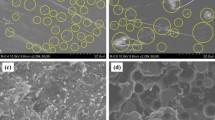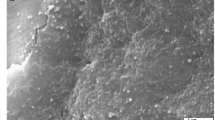Abstract
Hollow silica nanospheres (HSNs) have superior properties such as low density, low dielectric constant, low thermal conductivity, good sound absorption, dispersibility, fluidity, and stability. They have the potential to be utilised as a reinforcing material in the development of next generation composites due to their properties. Epoxy is one of the commonly utilised polymers in today’s technology. Production of epoxy matrix composite materials reinforced with particles having superior properties will open up new application areas for epoxy. In this study, mesoporous HSNs were produced. The mechanical, thermal and sound insulation properties of the composite were examined by reinforcing these mesoporous HSNs to the epoxy matrix. The epoxy matrix was reinforced with HSNs at 1 wt.%, 5 wt.%, and 10 wt.%. When the concentration of HSNs in the epoxy matrix was increased, its strength increased and its ductility decreased. While the non-reinforced epoxy had a tensile strength of 36.45 MPa, but the tensile strength of epoxy at the end of 10% HSN reinforcement reached 89.06 MPa. The strain % reduced in half. The sound insulation properties of epoxy improved as the concentration of HSNs increased. Thermal conductivity coefficient dropped up to a 5% reinforcement ratio, and then increased slightly at a 10% reinforcement ratio. The microstructure analyses indicated that when the reinforcement ratio increased, difficulties in the distribution of reinforcements to the matrix appeared. Furthermore, it was observed that when the matrix/reinforcement interface was improved, the properties of the composite improved.













Similar content being viewed by others
References
Zheng Y, Zheng Y, Ning R (2003) Effects of nanoparticles SiO2 on the performance of nanocomposites. Mater Lett 57:2940–2944
Toldy A, Szolnoki B, Marosi G (2011) Flame retardancy of fibre-reinforced epoxy resin composites for aerospace applications. Polym Degrad Stab 96:371–376
Gao G, Hu Y, Jia H, Liu P, Du P, Xu D (2019) Acoustic and dielectric properties of epoxy resin/hollow glass microsphere composite acoustic materials. J Phys Chem Solids 135:109105
Aradhana R, Mohanty S, Nayak SK (2019) Novel electrically conductive epoxy/reduced graphite oxide/silica hollow microspheres adhesives with enhanced lap shear strength and thermal conductivity. Compos Sci Technol 169:86–94
Bertling J, Blömer J, Kümmel R (2004) Hollow microsperes. Chem Eng Technol Ind Chem Plant Equipment-Process Eng Biotechnol 27:829–837
Zhu B, Wang J, Zheng H, Ma J, Wu J, Wu R (2015) Investigation of thermal conductivity and dielectric properties of LDPE-matrix composites filled with hybrid filler of hollow glass microspheres and nitride particles. Compos B Eng 69:496–506
Yung KC, Zhu B, Yue TM, Xie C (2009) Preparation and properties of hollow glass microsphere-filled epoxy-matrix composites. Compos Sci Technol 69:260–264
Vlassov S, Oras S, Timusk M, Zadin V, Tiirats T, Sosnin IM, Lõhmus R, Linarts A, Kyritsakis A, Dorogin LM (2022) Thermal, Mechanical, and Acoustic Properties of Polydimethylsiloxane Filled with Hollow Glass Microspheres. Materials 15:1652
Wang H, Hou F, Chang C (2020) Experimental and computational modeling of thermal conductivity of cementitious syntactic foams filled with hollow glass microspheres. Constr Build Mater 265:120739
Liu C, Kim JS, Kwon Y (2016) Comparative investigation on thermal insulation of polyurethane composites filled with silica aerogel and hollow silica microsphere. J Nanosci Nanotechnol 16:1703–1707
Cao X, Wen J, Song L, Liu X, He G (2021) Polyimide hollow glass microspheres composite films with low dielectric constant and excellent thermal performance. J Appl Polym Sci 138:50600
Zhu B, Ma J, Wang J, Wu J, Peng D (2012) Thermal, dielectric and compressive properties of hollow glass microsphere filled epoxy-matrix composites. J Reinf Plast Compos 31:1311–1326
Zhu B, Zheng H, Wang J, Ma J, Wu J, Wu R (2014) Tailoring of thermal and dielectric properties of LDPE-matrix composites by the volume fraction, density, and surface modification of hollow glass microsphere filler. Compos B Eng 58:91–102
Pakdel E, Naebe M, Kashi S, Cai Z, Xie W, Yuen ACY, Montazer M, Sun L, Wang X (2020) Functional cotton fabric using hollow glass microspheres: Focus on thermal insulation, flame retardancy, UV-protection and acoustic performance. Prog Org Coat 141:105553
Yang P, Ding J, Guo J, Shi W, Hu JJ, Wang C (2013) A strategy for fabrication of uniform double-shell hollow microspheres as effective acoustic echo imaging contrast agents through a new polymer-backbone-transition method. J Mater Chem B 1:544–551
Zhang Z, Jiang H, Li R, Gao S, Wang Q, Wang G, Ouyang X, Wei H (2021) High-damping polyurethane/hollow glass microspheres sound insulation materials: Preparation and characterization. J Appl Polym Sci 138:49970
Shi X, Wu J, Wang X, Zhou X, Xie X, Xue Z (2017) Novel sound insulation materials based on epoxy/hollow silica nanotubes composites. Compos B Eng 131:125–133
Yang H, Jiang Y, Liu H, Xie D, Wan C, Pan H, Jiang S (2018) Mechanical, thermal and fire performance of an inorganic-organic insulation material composed of hollow glass microspheres and phenolic resin. J Colloid Interface Sci 530:163–170
Wang Y, Meng X, Wang C, Han Z, Shi H (2021) Fire reaction properties of polystyrene-based composites using hollow silica as synergistic agent. J Therm Anal Calorim 146:1679–1686
Jiao C, Wang H, Li S, Chen X (2017) Fire hazard reduction of hollow glass microspheres in thermoplastic polyurethane composites. J Hazard Mater 332:176–184
Chen K, Tan Y, Wang K, Niu J, Chen ZY (2022) High specific capacity of carbon coating lemon-like SiO2 hollow spheres for lithium-ion batteries. Electrochim Acta 401:139497
Han Y, Guo Z, Teng S, Xia H, Wang D, Han M-Y, Yang W (2019) Rationalized fabrication of structure-tailored multishelled hollow silica spheres. Chem Mater 31:7470–7477
Nuruzzaman M, Ren J, Liu Y, Rahman MM, Shon HK, Naidu R (2019) Hollow porous silica nanosphere with single large pore opening for pesticide loading and delivery. ACS Appl Nano Mater 3:105–113
Dong Z, Jiang M-Y, Shi J, Zheng M-M, Huang F-H (2019) Preparation of immobilized lipase based on hollow mesoporous silica spheres and its application in ester synthesis. Molecules 24:395
Buttersack C (2019) Modeling of type IV and V sigmoidal adsorption isotherms. Phys Chem Chem Phys 21:5614–5626
Ambroz F, Macdonald TJ, Martis V, Parkin IP (2018) Evaluation of the BET Theory for the Characterization of Meso and Microporous MOFs. Small Methods 2:1800173
Aradhya R, Renukappa NM (2018) In: Maalawi KY (ed) Optimum Composite Structures. IntechOpen, London
Sun Y, Zhang Z, Moon KS, Wong C (2004) Glass transition and relaxation behaviour of epoxy nanocomposites. J Polym Sci Part B Polym Phys 42:3849–3858
Maity P, Kasisomayajula SV, Parameswaran V, Basu S, Gupta N (2008) Improvement in surface degradation properties of polymer composites due to pre-processed nanometric alumina fillers. IEEE Trans Dielectr Electr Insul 15:63–72
Ghadimi-Herfeh F, Rahimi A, ErshadLangroudi A (2014) Investigation of SiO2- epoxy and SiO2-TiO2-epoxy nanocomposite coatings via Taber abrasion experiment. 11th International Seminar on Polymer Science and Technology
Zhao R, Luo W (2008) Fracture surface analysis on nano-SiO2/epoxy composite. Mater Sci Eng A 483:313–315
Lu S-r, Hongyu J, H-l Z, Wang X-y (2005) Wear and mechanical properties of epoxy/SiO2-TiO2 composites. J Mater Sci 40:2815–2821
Lee J-W, Lee J-C, Pandey J, Ahn S-H, Kang YJ (2010) Mechanical properties and sound insulation effect of ABS/carbon-black composites. J Compos Mater 44:1701–1716
Kaya GG, Yilmaz E, Deveci H (2018) Sustainable nanocomposites of epoxy and silica xerogel synthesized from corn stalk ash: Enhanced thermal and acoustic insulation performance. Compos B Eng 150:1–6
Bao Y, Wang T, Kang Q, Shi C, Ma J (2017) Micelle-template synthesis of hollow silica spheres for improving water vapor permeability of waterborne polyurethane membrane. Sci Rep 7:1–14
Li G, He Y, Zhu P, Zhao T, Sun R, Lu D, Wong C-p (2018) Tailored surface chemistry of SiO2 particles with improved rheological, thermal-mechanical and adhesive properties of epoxy based composites for underfill applications. Polymer 156:111–120
Guchait A, Saxena A, Chattopadhyay S, Mondal T (2022) Influence of Nanofillers on Adhesion Properties of Polymeric Composites. ACS Omega 7:3844–3859
Jiang F, Li Z, Ji X, Gao C, Niu C (2020) Preparation and properties of hollow ceramic spheres-epoxy dielectric composites. IEEE Trans Dielectr Electr Insul 27:842–847
Author information
Authors and Affiliations
Corresponding author
Ethics declarations
Competing of interests
The authors declare that they have no known competing financial interests or personal relationships that could have appeared to influence the work reported in this paper.
Additional information
Publisher's Note
Springer Nature remains neutral with regard to jurisdictional claims in published maps and institutional affiliations.
Rights and permissions
Springer Nature or its licensor (e.g. a society or other partner) holds exclusive rights to this article under a publishing agreement with the author(s) or other rightsholder(s); author self-archiving of the accepted manuscript version of this article is solely governed by the terms of such publishing agreement and applicable law.
About this article
Cite this article
Demir, E., Güler, Ö. Production and properties of epoxy matrix composite reinforced with hollow silica nanospheres (HSN): mechanical, thermal insulation, and sound insulation properties. J Polym Res 29, 477 (2022). https://doi.org/10.1007/s10965-022-03322-w
Received:
Accepted:
Published:
DOI: https://doi.org/10.1007/s10965-022-03322-w




